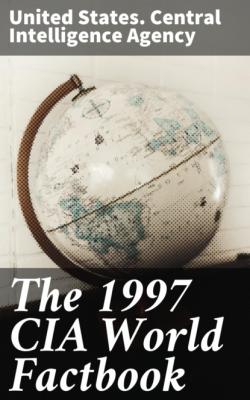The 1997 CIA World Factbook. United States. Central Intelligence Agency
Чтение книги онлайн.
Читать онлайн книгу The 1997 CIA World Factbook - United States. Central Intelligence Agency страница 13
 expenditures - dollar figure: $NA
expenditures - dollar figure: $NA
Military expenditures - percent of GDP: NA%
Transnational Issues
Disputes - international: some support from RABBANI and MASOOD to anti-government Islamic fighters in Tajikistan's civil war; support to Islamic militants worldwide by some factions; question over which group should hold Afghanistan's seat at the UN
Illicit drugs: world's second-largest illicit opium producer after
Burma (1,230 metric tons in 1996 - down 2% from 1995) and a major
source of hashish
______________________________________________________________________
ALBANIA
@Albania:Geography
Location: Southeastern Europe, bordering the Adriatic Sea and Ionian
Sea, between Greece and Serbia and Montenegro
Geographic coordinates: 41 00 N, 20 00 E
Map references: Europe
Area: total: 28,750 sq km land: 27,400 sq km water: 1,350 sq km
Area - comparative: slightly smaller than Maryland
Land boundaries: total: 720 km border countries: Greece 282 km, The Former Yugoslav Republic of Macedonia 151 km, Serbia and Montenegro 287 km (114 km with Serbia, 173 km with Montenegro)
Coastline: 362 km
Maritime claims: continental shelf: 200-m depth or to the depth of exploitation territorial sea : 12 nm
Climate: mild temperate; cool, cloudy, wet winters; hot, clear, dry summers; interior is cooler and wetter
Terrain: mostly mountains and hills; small plains along coast
Elevation extremes: lowest point: Adriatic Sea 0 m highest point : Maja e Korabit 2,753 m
Natural resources: petroleum, natural gas, coal, chromium, copper, timber, nickel
Land use: arable land: 21% permanent crops: 5% permanent pastures: 15% forests and woodland: 38% other: 21% (1993 est.)
Irrigated land: 3,410 sq km (1993 est.)
Natural hazards: destructive earthquakes; tsunamis occur along southwestern coast
Environment - current issues: deforestation; soil erosion; water pollution from industrial and domestic effluents
Environment - international agreements: party to: Biodiversity, Climate Change, Wetlands signed, but not ratified : none of the selected agreements
Geography - note: strategic location along Strait of Otranto (links
Adriatic Sea to Ionian Sea and Mediterranean Sea)
@Albania:People
Population: 3,299,757 (July 1997 est.)
Age structure: 0–14 years: 34% (male 575,087; female 534,618) 15–64 years: 60% (male 927,791; female 1,068,922) 65 years and over: 6% (male 80,135; female 113,204) (July 1997 est.)
Population growth rate: 0.9% (1997 est.)
Birth rate: 21.96 births/1,000 population (1997 est.)
Death rate: 7.54 deaths/1,000 population (1997 est.)
Net migration rate: −5.46 migrant(s)/1,000 population (1997 est.)
Sex ratio: at birth: 1.08 male(s)/female under 15 years: 1.08 male(s)/female 15–64 years: 0.87 male(s)/female 65 years and over : 0.71 male(s)/female total population: 0.92 male(s)/female (1997 est.)
Infant mortality rate: 47.1 deaths/1,000 live births (1997 est.)
Life expectancy at birth: total population : 68.28 years male: 65.24 years female: 71.55 years (1997 est.)
Total fertility rate: 2.64 children born/woman (1997 est.)
Nationality: noun: Albanian(s) adjective: Albanian
Ethnic groups: Albanian 95%, Greeks 3%, other 2% (Vlachs, Gypsies, Serbs, and Bulgarians) (1989 est.) note: in 1989, other estimates of the Greek population ranged from 1% (official Albanian statistics) to 12% (from a Greek organization)
Religions: Muslim 70%, Albanian Orthodox 20%, Roman Catholic 10% note: all mosques and churches were closed in 1967 and religious observances prohibited; in November 1990, Albania began allowing private religious practice
Languages: Albanian (Tosk is the official dialect), Greek
Literacy: definition: age 9 and over can read and write total population: 72% male: 80% female: 63% (1955 est.)
@Albania:Government
Country name: conventional long form: Republic of Albania conventional short form: Albania local long form: Republika e Shqiperise local short form: Shqiperia former: People's Socialist Republic of Albania
Data code: AL
Government type: emerging democracy
National capital: Tirane
Administrative divisions: 26 districts (rrethe, singular - rreth);
Berat, Dibre, Durres, Elbasan, Fier, Gjirokaster, Gramsh, Kolonje,
Korce, Kruje, Kukes, Lezhe, Librazhd, Lushnje, Mat, Mirdite, Permet,
Pogradec, Puke, Sarande, Shkoder, Skrapar, Tepelene, Tirane, Tropoje,
Vlore
note: some new administrative units may have been created
Independence: 28 November 1912 (from Ottoman Empire)
National holiday: Independence Day, 28 November (1912)
Constitution: an interim basic law was approved by the People's Assembly on 29 April 1991; a draft constitution was rejected by popular referendum in the fall of 1994 and a new draft is pending
Legal system: has not accepted compulsory ICJ jurisdiction
Suffrage: 18 years of age; universal and compulsory
Executive branch: chief of state : President of the Republic Sali BERISHA (since 9 April 1992) head of government: Prime Minister of the interim National Reconciliation Government Bashkim FINO (since 12 March 1997) cabinet: Council of Ministers appointed by the president elections: president elected by the People's Assembly for a five-year term; election last held NA 1992 (next to be held NA March 1997); prime minister appointed by the president election results : Sali BERISHA elected president; percent of People's Assembly vote - NA
Legislative branch: unicameral People's Assembly